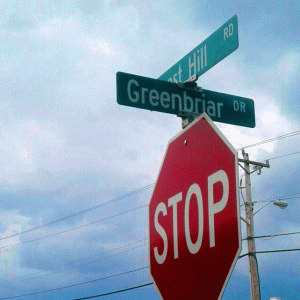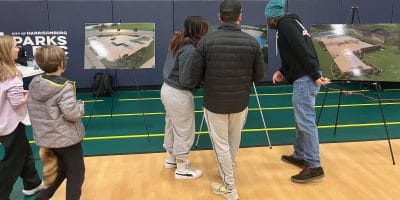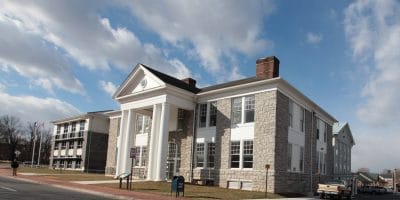By Harrison Horst, senior contributor
Two visions about the future of housing in Harrisonburg have been colliding in a neighborhood tucked between JMU’s ever expanding East Campus and the heavily-traveled Port Republic Road corridor.
This clash of perspectives created some friction, starting with the May planning commission meeting when 11 neighborhood residents wrote letters and one neighbor organized a petition with almost 40 signatures in protest of a rezoning request in the neighborhood. The application sought to loosen the zoning restrictions for three properties at the entrance to the neighborhood — a move that would make it easier to rent the houses to college students.
Meanwhile, another resident organized a counter petition with another 40 names in support of the zoning change.
Then at the meeting, eight homeowners took their turns speaking at the public hearing to urge the planning commission to turn down the request. They cited the character of the neighborhood and concerns over traffic and noise.
One neighborhood. Two distinct perspectives.
Although the short-term rentals discussed in the first half of the planning commission’s meeting made the immediate headlines, the Greenbriar Drive request generated almost an hour of comment and discussion, revealing not only the tensions in one neighborhood but also the zoning- and planning-related growing pains spawned by a university that has nearly doubled in enrollment over the last 20 years. While many of those students live in apartment complexes further from campus, some rent houses close by — including on Greenbriar Drive.
During the public comments, one resident who spoke against the proposal played a recording on his phone of a loud party that he said was taken “at 11 o’clock at night.” Another resident even suggested that the homeowners use the money they’ve earned from renting the house to “sell [it] and buy another property, please.”
Tension between college students and local property-owning residents is common around many campuses — and those in Harrisonburg are no exceptions — but on Greenbriar Dr., that relationship seems particularly strained.
Changing neighborhood?
 Greenbriar Drive is a neighborhood road just off of Port Republic Road that ends in a lightly wooded cul-de-sac. Across the street from the neighborhood entrance sits a Days Inn, which guards the entrance to the rest of the neighborhood, commonly called “Forest Hills.” Farther up Greenbriar, the mid-sized ranchers give way to large modern multi-story homes at the crest of the hill. Behind the houses on the south side of the road is a row of large trees that don’t quite hide the row of apartments along nearby Village Lane that house mostly JMU students.
Greenbriar Drive is a neighborhood road just off of Port Republic Road that ends in a lightly wooded cul-de-sac. Across the street from the neighborhood entrance sits a Days Inn, which guards the entrance to the rest of the neighborhood, commonly called “Forest Hills.” Farther up Greenbriar, the mid-sized ranchers give way to large modern multi-story homes at the crest of the hill. Behind the houses on the south side of the road is a row of large trees that don’t quite hide the row of apartments along nearby Village Lane that house mostly JMU students.
The three houses at the crux of the issue are just at the turnoff onto Greenbriar Drive: 706, 710, and 714. The application’s authors, Johann Vargas and Julian Peña, own and reside at one of the three.
Carolyn Frank and her husband Rob, who own 710 Greenbriar Dr. and currently lease to a single family, joined Vargas and Peña in the application after they approached the Franks to see if they were on board.
“They just called us to ask if we had any objections, and of course we said, ‘No – in fact, we want to join in with you,’” said Carolyn Frank, a former Harrisonburg mayor.
With Harrisonburg facing a housing crunch, many of the decisions the planning commission have made lately often lead to some discussion, or at least some mention of, creating or preserving affordable housing. Even the recent discussions around short-term rental applications touched on it.
The Greenbriar Drive discussion is no exception.
A few of the letters written in opposition to the rezoning cited a lack of available single-family housing in the city, a point reiterated by several of the neighborhood residents at the meeting.
Amid a crunch
A market analysis report put out by the Harrisonburg Housing and Redevelopment Authority shows that median household incomes in the city have lagged behind the rate of inflation, at 10 and 18 percent, respectively.
On top of that, as demand for homes in Harrisonburg continues to rise, so do the prices homes and rentals alike. Harrisonburg’s 2018 Comprehensive Plan shows that more than 65 percent of renters in Harrisonburg now have to devote over a quarter of their income to rent, up from about 50 percent in 2000.
Low-density single-family housing is most often translated in zoning lingo as “R-1,” one of the city’s more restrictive forms of residential zoning and is meant to encourage single-family occupancy and low-density housing. The properties at 706, 710, and 714 Greenbriar Dr. are currently zoned R-1, along with the rest of the properties on Greenbriar Drive. But the applicants want them to be zoned R-3C, which would allow for up to four unrelated occupants. For Vargas, Peña and the Franks, a higher-density zoning makes more sense for their properties because they are bordered by a hotel on one side and high-density student townhouses on another.
“We’re next door to 48 students to acre. So I thought it made sense and was fair and reasonable, that we’re the buffer for the Forest Hills neighborhood from the fraternity house and those 24 students,” said Rob Frank. “And there isn’t ever going to be another house in the Forest Hills neighborhood that could say the same thing.”
“There are some clear neighborhoods, like, this is clearly R-1,” Carolyn Frank added. The house she owns, 710 Greenbriar Dr., she said “is not clearly R-1 — with Village Lane dumping out on us, and the hotel.”
In his appeal to the commission, Peña also pointed out the high amount of foot and vehicle traffic seen by the property.
“If we were to sell our house, I do not think that you would see a single family interested in buying it,” he said. “These homes are not fit for single-family living. They are not.” Vargas and Peña declined to comment for this article.
Effects of students?
The Franks said they’ve never received a complaint from their tenants, but during the public hearing, neighbors mentioned various public disturbances from college-age residents, including broken fences, late-night noise, an abundance of trash, and knocked-down mailboxes.
The Village Lane Apartments, which are south of Greenbriar Drive, were the site of the 2010 riots, when Harrisonburg police used tear gas and pepper spray to disperse a block party of more than 8,000 people. The Franks said adding a house of four students won’t make a difference, but some neighbors – and the planning commission – didn’t agree.
“We’ve always had families, directly beside us, across from us, just like our family,” said Greg Bellamy, a Greenbriar Dr. resident, in a phone call with The Citizen. “And we like being close, the location is fantastic, get on 81, get downtown. We like that about it, and still do. We like everything about our neighborhood.”
Bellamy – and the other neighbors who showed up – said they are worried that a change in zoning could lead to additional student housing in their neighborhood, which could in turn affect its family-friendly character.
“The one house that’s owned by the two gentlemen that wanted to change the zoning, I’d suggest you drop by our street, it’ll take you two seconds to figure out which house they want to change to student housing, based on the appearance,” said Bellamy.
Bellamy’s concerns about appearance go beyond neighborhood aesthetics. Unkempt lots and vacancy can lower the property value of neighboring lots, which is a big deal for homeowners who have invested their life savings into a home.
“I am now a homeowner, so I understand and share the concerns of people of what might happen to their property value,” said Commissioner Brent Finnegan, in a phone interview with The Citizen. “If someone’s net worth is wrapped up in their house, then planning commission, I don’t see it as our role to be fiduciaries. We have to act in what is in the best interest of the city, not the best interest of a property owner or applicant or neighborhood.”
Finnegan was the lone dissenting vote in planning commission’s vote to recommend denial of the request. The application eventually went on to city council last month, where it was denied unanimously.
“One of the reasons I voted against the denial of that request was I wanted there to be a reflection of the names that were on the list in favor of the rezoning. A lot of those folks are renters,” Finnegan said.
Homeowners’ and renters’ voices
The petition Finnegan mentioned was organized by Vargas and Peña and also garnered more than 30 signatures, most of whom claimed an address at the apartments on Village Lane or the townhomes on Greenbriar. Bellamy pointed out that a number of these residents may not be full-year tenants, but Finnegan says that’s the very reason he considered the petition.
“I feel like a lot of times renters aren’t given the same opportunity, the same weight, in terms of what we take into consideration when considering a request like that,” said Finnegan. “And I had never seen, in my two and a half years on planning commission, a list that included renters on any kind of petition. So when I see that, I pay attention.”
When a public decision comes to planning commission or city council, the decision is often swayed by the homeowners who show up — those who are permanent residents and, thus, are likely to be affected by changes to the neighborhood years down the road. But Finnegan said that is also a problem because homeowners only make up about 37 percent of Harrisonburg residents, one of the lowest rates in the state.
Meanwhile, every name on the “against” petition comes from homeowners further into the neighborhood, on Oak Hill Drive. and Ridgewood Road. In fact, none of those who signed the petition against the application — and very few of those who spoke during the public hearing portion of the May 8 meeting — were actually residents of Greenbriar Drive.
“The main opposition was the Forest Hills neighborhood, up on the hill,” said Rob Frank. “And we didn’t feel it was really going to be impacting them at all. I guess they were afraid we’d get ours rezoned, and then a house over there would want to get rezoned, the creep effect, that it would be setting a precedent.”
Creep and domino effects
The “creep effect” and its sister concept, the “domino effect,” are often invoked as rationale in planning commission meetings. Essentially, once one change is approved in a neighborhood, it sets a precedent for other neighborhood residents who may also find the change beneficial, leading to a “tragedy of the commons”-esque chain reaction. While the Greenbriar Dr. applicants think this application represents a small change, from the planning commission’s perspective, there’s no telling how many ripple effects it could have down the road. During the meeting, chair Henry Way noted that his time with the commission has made him “more and more intent…on standing as firm as we can on these edge cases.”
Finnegan also said the planning commission powers are more limited than some might think, especially when it comes to the growth of the state-owned university in town.
“When JMU increases its footprint, the city has less land to build on,” Finnegan said. That’s because Harrisonburg’s city borders are locked into place, thanks to a 1987 statewide restriction on annexation of county land by cities.
“So my concern is, given that limitation,” Finnegan added, “what can we do to maximize the amount of space that we have available for housing?”
Already, JMU has purchased almost all of the homes in the northwest part of the Forest Hills neighborhood. Once JMU becomes the owner of a property, “that property becomes state owned is no longer subject to local zoning laws,” said Harrisonburg zoning administrator Rachel Drescher. If JMU decides to use the properties they own in the Forest Hills neighborhood – which used to be R-1 single-family homes – for anything other than housing, the university can.
“I think with JMU’s growth…. I think our street, Greenbriar, could very well end up being possibly on JMU’s radar for future purchase at some time. I would have no idea of what that timeframe looks like or when that may be,” Bellamy said.
There are far more immediate changes coming to the neighborhood as well. Next year, the city has plans to change the northbound I-81 off-ramp so that it leads directly into the Forest Hills neighborhood, which will help smoothen the flow of traffic on graduation weekends – and also increase the amount of traffic driving past 706 Greenbriar Dr.
But, for now, the planning commission and city council appear committed to preserving the low-density feel of the Forest Hills neighborhood for as long as possible. When the application was brought before city council, Councilman Richard Baugh pointed out that they specifically discussed the fate of the Forest Hills neighborhood during their Comprehensive Plan conversations last year. Baugh said it was a “conscientious decision” to keep the neighborhood zoned R-1.
But from the Franks’ perspective, it doesn’t make sense that city leaders have dug their heels in on that.
“And some of the the things – noise, trash – that’s not going to change with our rezoning. You still have Village Lane, you still have the townhouses, and you’ll still have parties,” said Carolyn Frank at the June 11 city council meeting. “Just remember, either way, this is not going to change some of the problems that people are talking about.”
“[A friend] told me one time, you can’t be against everything,” said Rob Frank. “So what’s going to end up with our house? I don’t know, but there are worse things than four students living in a house.”
Clarification: This article was updated to clarify the description of R-1 zoning as one of the more restrictive types meant to encourage single-family occupancy.
Journalism is changing, and that’s why The Citizen is here. We’re independent. We’re local. We pay our contributors, and the money you give goes directly to the reporting. No overhead. No printing costs. Just facts, stories and context. Thanks for your support.











